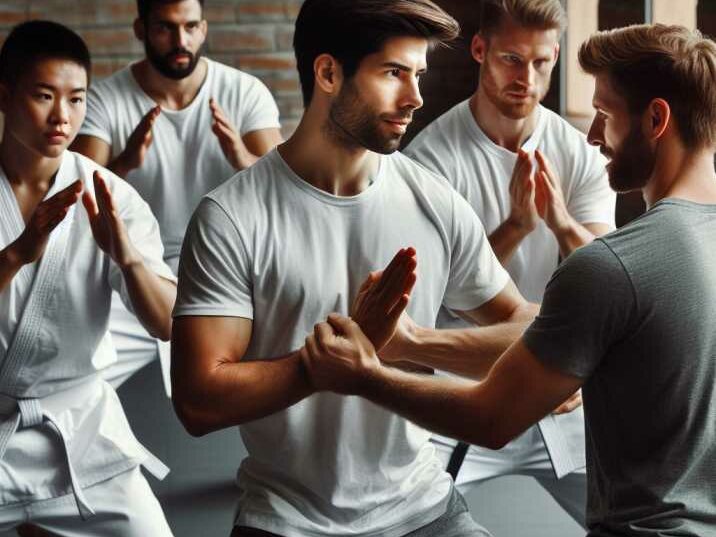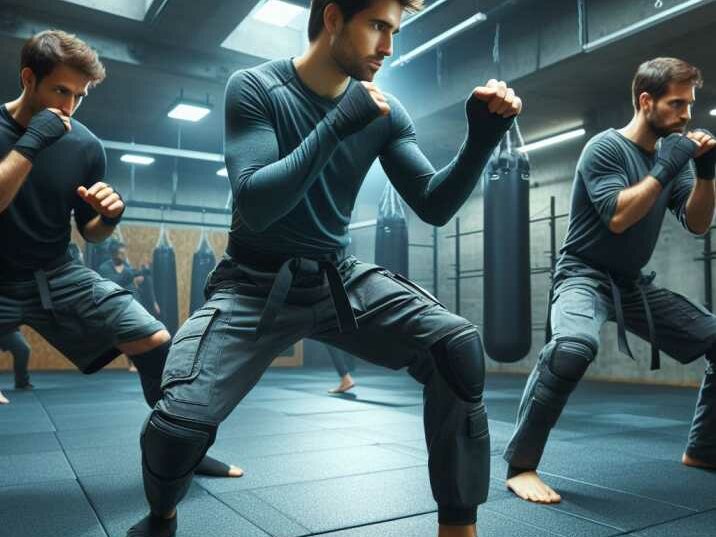Introduction:
Table of Contents
Embarking on the journey of martial arts is not just about offense; it’s also about mastering the art of defense. In this comprehensive guide, we’ll delve into the nuances of the best defensive stance in martial arts. From understanding its importance to practical techniques and applications, this guide is your ultimate resource for enhancing your defensive prowess.

Table of Contents
- Introduction
- The Significance of Defensive Stance in Martial Arts
- Understanding the Defensive Mindset
- Delving into the psychology of defense and its role in martial arts training.
- Importance of Balance and Stability
- Exploring how balance and stability form the foundation of effective defense.
- Building Blocks of Effective Defense
- Breaking down the essential components of a solid defensive stance.
- Elements of an Effective Defensive Stance
- Proper Foot Positioning
- Alignment of Body and Limbs
- Hand Placement and Guard Position
- Maintaining Flexibility and Mobility
- Exploring Different Defensive Stances
- Neutral Stance: Foundation of Defense
- Side Stance: Mobility and Counterattacks
- Back Stance: Defensive Retreat and Evasion
- Techniques for Refining Your Defensive Stance
- Mirror Training: Visual Feedback for Improvement
- Shadowboxing: Practicing Defense in Motion
- Partner Drills: Realistic Application and Response
- Adapting Defensive Stance to Various Martial Arts
- Taekwondo: Dynamic Stances for Kicking
- Karate: Balanced and Grounded Defense
- Judo: Utilizing Throws and Grappling
- Common Errors in Defensive Stance and How to Correct Them
- Leaning Too Far Forward or Backward
- Neglecting Footwork and Mobility
- Tension in Muscles: Relaxation is Key
- The Mental Aspect of Defensive Stance
- Developing Focus and Awareness
- Cultivating a Calm and Resilient Mindset
- Visualization Techniques for Mental Preparation
- Drilling and Sparring for Practical Application
- Controlled Sparring Sessions
- Scenario-Based Training for Realistic Situations
- Feedback and Analysis for Continuous Improvement
- Integrating Defensive Stance into Self-Defense
- Assessing Potential Threats and Dangers
- Using Verbal and Non-Verbal Defense Tactics
- Escaping and Evasion Techniques
- Evolution of Defensive Stance in Modern Martial Arts
- Influence of Traditional and Contemporary Styles
- Incorporating Technology and Training Innovations
- Adapting to Changing Combat Environments
- Conclusion
1. The Significance of Defensive Stance in Martial Arts
Understanding the Defensive Mindset:
In martial arts, defense is as crucial as offense. Understanding the defensive mindset is the cornerstone of effective martial arts training. It involves delving into the psychology of defense and how it shapes our reactions to threats. Maintaining a defensive mindset enables practitioners to anticipate attacks and respond effectively, ensuring their safety in combat situations.
Importance of Balance and Stability:
Balance and stability are fundamental aspects of effective defense. In martial arts, maintaining a stable base allows practitioners to move swiftly and efficiently while defending against incoming attacks. Exploring the biomechanics of balance reveals how proper weight distribution and alignment contribute to a strong defensive stance, enabling practitioners to withstand and counteract opponents’ strikes.
Building Blocks of Effective Defense:
A solid defensive stance comprises several essential components. Proper posture, footwork, and hand placement are the building blocks of effective defense. By maintaining correct alignment and positioning, practitioners create a strong defensive foundation that optimizes their ability to protect themselves. Additionally, emphasizing breathing techniques aids in maintaining composure and conserving energy during defensive maneuvers
2. Elements of an Effective Defensive Stance
Proper Foot Positioning:
Foot positioning plays a pivotal role in maintaining balance and stability during defensive maneuvers. Practitioners must understand the importance of placing their feet correctly and distributing their weight evenly. Tips on maintaining a balanced stance, adjusting foot position according to the direction of attacks, and positioning toes slightly inward for stability enhance defensive capabilities.
Alignment of Body and Limbs:
Alignment of the body and limbs maximizes defensive coverage, minimizing vulnerability to attacks. Aligning the body with the direction of incoming strikes reduces their impact and creates openings for counterattacks. Moreover, adhering to the centerline theory influences defensive positioning, optimizing defensive capabilities against various attack angles.
Hand Placement and Guard Position:
Hand placement and guard position are critical aspects of effective defense. Different hand positions and guard variations offer optimal protection against strikes to vulnerable areas such as the face and torso. Practitioners must maintain relaxed yet ready hands to defend or counterstrike effectively, ensuring their readiness in combat situations.
Maintaining Flexibility and Mobility:
Flexibility and mobility are essential for adapting to changing combat scenarios. Stretching exercises and mobility drills improve joint flexibility, enabling practitioners to move fluidly within their defensive stance. Dynamic movement within the stance enhances evasion tactics and creates opportunities for effective counterattacks.
3. Exploring Different Defensive Stances
Neutral Stance: Foundation of Defense:
The neutral stance serves as the foundation of defense in various martial arts disciplines. Its versatility allows practitioners to transition seamlessly between offensive and defensive techniques. Understanding the neutral stance and its variations enables practitioners to adapt their defensive strategies to different martial arts styles and combat scenarios.
Side Stance: Mobility and Counterattacks:
The side stance offers mobility and facilitates quick counterattacks. Its lateral movement capability allows practitioners to evade strikes while maintaining a strong defensive position. Practicing lateral movement and counterattacks from the side stance enhances defensive reflexes and tactical maneuverability in combat.
Back Stance: Defensive Retreat and Evasion:
The back stance is employed for defensive retreat and evasion tactics. By creating distance from opponents while remaining prepared to counterattack, practitioners can effectively defend themselves against aggressive opponents. Practicing defensive movement and evasion drills from the back stance enhances practitioners’ ability to escape dangerous situations unscathed.
4. Techniques for Refining Your Defensive Stance
Mirror Training: Visual Feedback for Improvement:
Mirror training provides visual feedback for analyzing and refining defensive stance technique. Practicing defensive movements in front of a mirror helps identify and correct technical errors, improving form and posture. Focusing on proper technique during mirror training sessions enhances practitioners’ defensive capabilities.
Shadowboxing: Practicing Defense in Motion:
Shadowboxing allows practitioners to simulate real-life defensive scenarios in a dynamic manner. Without the need for a training partner, practitioners can practice defensive movements and counters fluidly. Visualizing opponent attacks during shadowboxing sessions sharpens defensive reflexes and enhances situational awareness in combat.
Partner Drills: Realistic Application and Response:
Engaging in partner drills offers realistic combat scenarios for practicing defensive techniques. Partner drills simulate dynamic combat situations, allowing practitioners to refine defensive reflexes and timing. Effective communication and cooperation between training partners enhance the learning experience and promote mutual improvement.
5. Adapting Defensive Stance to Various Martial Arts
Taekwondo: Dynamic Stances for Kicking:
In taekwondo, dynamic defensive stances accommodate powerful kicking techniques. Practitioners utilize a combination of defensive stances and footwork to create openings for high-impact kicks. Tailoring defensive strategies to specific taekwondo techniques and sparring scenarios optimizes practitioners’ defensive capabilities.
Karate: Balanced and Grounded Defense:
Karate emphasizes grounded defensive stances for stability and power generation. Deep stances such as zenkutsu dachi and kokutsu dachi create a strong defensive base, enabling practitioners to withstand opponents’ attacks. Unique defensive techniques in karate, such as forearm blocks and circular movements, enhance defensive versatility.
Judo: Utilizing Throws and Grappling:
In judo, defensive stances integrate with throwing and grappling techniques for effective defense. Defensive stances such as jigotai and kumikata maintain balance and control while defending against throws and takedowns. Practicing defensive grips and footwork in judo randori sessions enhances practitioners’ defensive capabilities in live sparring.
6. Common Errors in Defensive Stance and How to Correct Them
Leaning Too Far Forward or Backward:
Common postural mistakes, such as leaning too far forward or backward, compromise balance and stability. Practicing proper posture and weight distribution through drills improves balance and prevents leaning. Keeping the head centered and aligned with the spine enhances balance and reduces telegraphing movements.
Neglecting Footwork and Mobility:
Neglecting footwork drills diminishes agility and mobility, limiting defensive capabilities. Footwork exercises such as ladder drills and cone drills enhance agility and mobility in defensive movements. Constant movement and angle changes disrupt opponents’ rhythm and create opportunities for counterattacks.
Tension in Muscles: Relaxation is Key:
Tension in muscles leads to fatigue and stiffness, impairing defensive effectiveness. Breathing exercises and relaxation techniques promote muscle relaxation, enhancing fluidity in movements. Maintaining mental relaxation and focus cultivates a calm and composed demeanor, essential for effective defense in combat.
7. The Mental Aspect of Defensive Stance
Developing Focus and Awareness:
Cultivating mental focus and situational awareness is essential for effective defense. Mindfulness exercises and visualization techniques sharpen focus and enhance awareness in combat situations. Maintaining awareness of opponents’ movements while staying calm and composed optimizes defensive responses.
Cultivating a Calm and Resilient Mindset:
Maintaining composure and resilience under pressure is crucial for effective defense. Mental conditioning exercises such as controlled breathing and positive self-talk promote calmness and focus in combat. Adapting to setbacks and maintaining confidence in one’s abilities fosters resilience and enhances defensive capabilities.
Visualization Techniques for Mental Preparation:
Harnessing the power of visualization mentally prepares practitioners for defensive scenarios. Guided visualization exercises visualize successful defensive techniques and responses to various attack scenarios. Visualizing successful outcomes and overcoming potential obstacles enhances mental readiness for combat.
8. Drilling and Sparring for Practical Application
Controlled Sparring Sessions:
Structured sparring sessions provide opportunities to test and refine defensive stance techniques. Controlled sparring offers realistic combat scenarios while minimizing the risk of injury. Setting rules and boundaries ensures safety and constructive feedback, optimizing learning and improvement.
Scenario-Based Training for Realistic Situations:
Simulating real-life scenarios develops adaptive defensive strategies. Scenario-based training drills, such as multiple attacker scenarios and weapon defense simulations, prepare practitioners for unexpected situations. Developing problem-solving skills and tactical awareness enhances readiness for diverse combat environments.
Feedback and Analysis for Continuous Improvement:
Seeking feedback from instructors and peers identifies areas for improvement in defensive stance technique and strategy. Constructive criticism and self-assessment refine defensive capabilities and promote growth. Effective feedback facilitates learning and continuous improvement in defensive skills.
9. Integrating Defensive Stance into Self-Defense
Assessing Potential Threats and Dangers:
Developing situational awareness and threat assessment skills is vital for effective self-defense. Recognizing potential threats and evaluating danger levels prepares practitioners to respond appropriately. Maintaining a proactive mindset and readiness for self-defense ensures personal safety in various situations.
Using Verbal and Non-Verbal Defense Tactics:
Utilizing verbal de-escalation techniques and non-verbal cues deters potential attackers. Communication skills and body language play crucial roles in diffusing potentially violent situations. Assertive yet non-aggressive verbal responses and non-threatening body postures enhance personal safety and prevent conflicts.
Escaping and Evasion Techniques:
Learning evasion techniques and escape strategies is essential for self-defense. Techniques such as ducking, weaving, and running create distance and minimize physical confrontation. Having multiple escape routes and using improvised weapons enhance readiness to defend oneself in dangerous situations.
10. Evolution of Defensive Stance in Modern Martial Arts
Influence of Traditional and Contemporary Styles:
The evolution of defensive stances reflects advancements in training methods and technology. Traditional martial arts principles influence modern combat sports such as MMA and BJJ. Integrating traditional and contemporary styles enhances defensive capabilities in diverse combat environments.
Incorporating Technology and Training Innovations:
Technology and innovative training methods shape the evolution of defensive stance training. Video analysis, virtual reality simulations, and biomechanical research improve defensive technique and performance. Specialized training equipment enhances training effectiveness and optimizes defensive skills development.
Adapting to Changing Combat Environments:
Adapting defensive stance techniques to evolving combat environments is essential for martial artists. Flexibility and adaptability in defensive strategies ensure effectiveness against different opponents and fighting styles. Combining elements of various martial arts styles creates hybrid systems tailored to specific combat scenarios.

Conclusion:
In conclusion, mastering the best defensive stance in martial arts is a journey of continuous learning and refinement. By understanding the importance of the defensive stance, refining your technique, and embracing a holistic approach that encompasses both physical and mental aspects, you can elevate your skills to new heights. Remember, the journey towards mastery is as rewarding as the destination itself. Keep practicing, stay vigilant, and never stop striving for improvement.
Frequently Asked Questions:
- What is the primary purpose of a defensive stance in martial arts?
- The defensive stance serves as the foundation for defense, providing protection and readiness to counterattacks.
- How can I improve my defensive stance technique?
- Practice proper foot positioning, body alignment, and hand placement through drills and repetition.
- Is there a universal defensive stance suitable for all martial arts?
- While principles may overlap, each martial art has its unique defensive stances tailored to its techniques and strategies.
- How can I maintain focus and awareness during combat situations?
- Practice mindfulness and visualization techniques to cultivate a calm and alert mindset.
- Can defensive stance training be beneficial for self-defense outside of martial arts practice?
- Yes, mastering defensive stance techniques can enhance your ability to protect yourself in various real-life situations.


